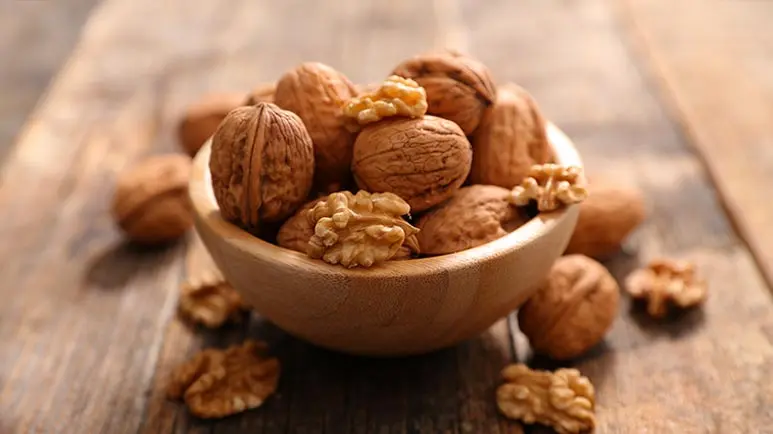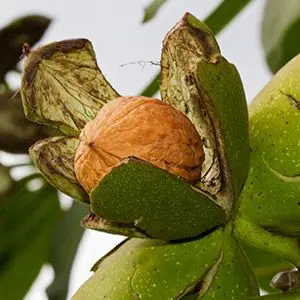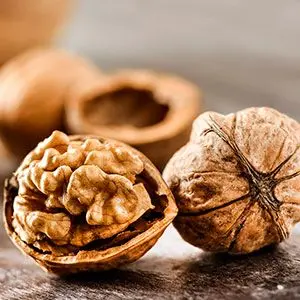Walnuts: Tiny Treat Packed with Big Benefits for Your Pet!
When offered in the proper way (chopped in small pieces), this popular tree nut can add a crunchy texture and a healthy dose of phytochemicals to your pet’s snack time. Learn more about its benefits here.

STORY AT-A-GLANCE
- A walnut half can be chopped into four training treats and fed to a 50-pound dog throughout the day
- A 2022 study in the journal Molecules examined the phenolic compounds in 10 different types of nuts, as well as peanuts; walnuts contained the highest amount of flavonoids
- Walnuts contain melatonin, which may offer many advantages for pets, such as regulating the immune system, scavenging free radicals due to its antioxidant effects and inducing restful sleep
- Warm temperatures can make walnuts go rancid easily. It’s best to keep them in the refrigerator so they’ll last longer
Editor's Note: This article is a reprint. It was originally published June 6, 2023.
Many healthy fruits, vegetables, nuts and seeds are safe for pets to consume, but there’s a lot of misinformation surrounding them on the internet. This is because websites have labeled all risks (such as the risk of overconsumption causing gastrointestinal issues, or choking on too large of pieces or pits) as "toxicities," which isn't true but has managed to confuse millions of pet lovers, nonetheless.
One food that has been given a bad rap for pets is walnuts — but only because pet parents are not always properly sharing them with their pet. The truth is, if given in the right manner, walnuts are one of the healthiest nuts you can share with pets, considering their impressive nutrient profile.
What Are Walnuts, and Are They Safe for Pets?
Walnuts grow on trees — in fact, they are the fruit of the trees from the genus Juglans. At first, they appear green, but as they ripen, they turn a pale yellow. Fully ripened walnuts then fall to the ground and are harvested. Once you take away the outer husk, it leaves a hard shell, which is also removed to get to the nut meat inside. Walnuts have two classifications:1
- English walnuts (Juglans regia) originated in the Middle East and are also known as Persian walnuts. They have a light gold color, with a mild flavor and a softer shell that is easier to remove.
- Black walnuts (Juglans nigra) are native to the U.S., specifically the eastern part, and are darker in appearance. As the name implies, they have a dark color, with a strong, earthy flavor and a hard shell that’s difficult to remove. The California black walnut (Juglans californica) is a type of black walnut.
Walnuts can be a safe addition to your pet’s lineup of healthy treats or part of a nutritionally adequate homemade diet. Of course, you should exercise common sense when sharing it with them; make sure to break them into small pieces before feeding, so they will not become a choking hazard. For example, a walnut half can be chopped into four training treats and fed to a 50-pound dog throughout the day. You can also crush walnuts into bits and sprinkle a small amount over their meals for added texture.
Did You Know?

Walnuts are not true botanical nuts. Rather, they are classified as stone fruits. In the culinary world, they are what’s called “tree nuts.”2
Make Sure Your Walnuts Are Mold-Free
There is one thing to remember before sharing walnuts with pets: Make sure the nuts do not have any mold. Molds that grow on these nuts contain a toxin that can be dangerous to dogs. Called tremorgenic mycotoxins, they can lead to seizures and other neurological issues if your pet is exposed to them.3,4 This can be easily avoided by making sure to store your walnuts properly (more on this later).
Black walnuts grow on trees encased in a tough, leathery outer shell that contains juglones, a substance that can cause gastrointestinal (GI) issues like upset stomach, vomiting and diarrhea in horses and dogs.5 Black walnut wood also contains this substance, so if you have a black walnut tree in your yard, make sure your dog does not chew the bark or consume the outer casing that protects the nuts.
Walnuts Offer Beneficial Phytochemicals
Walnuts are rich in fatty acids, containing about 40% to 70% oil. They contain omega-3 fats in the form of alpha-linolenic acid (ALA). These nuts are also rich in phytochemicals, namely phenolics, carotenoids, phytosterols and tocopherols. According to a 2023 study in Food Reviews International:6
“The presence of phytochemicals in walnuts gives rise to multiple bioactivities, such as antioxidant, anti-inflammatory properties, and cholesterol lowering activity. The addition of walnut to a diet could enable delay of the onset of neurodegenerative disorders [and] protection against the development of certain cancers.”
A 2022 study in the journal Molecules examined the phenolic compounds in 10 different types of nuts, as well as peanuts, and found that walnuts contained the highest amounts of flavonoids. The most abundant flavonoid in walnuts was epicatechin, which has “prominent biological properties, such as antioxidant, anti-inflammatory, antitumor and anti-diabetic.”7 In one mice study, epicatechin gave greater endurance to the test subjects by inducing structural and metabolic changes.8
Walnuts are also rich in alpha-tocopherols,9 also known as vitamin E. In pets, this essential nutrient helps promote immunity, gut health, and eye and skin health. It’s also crucial in helping build cell membranes, metabolize fat and synthesize other nutrients in the body, like vitamin C and ubiquinone.10
Which State Produces the Most Walnuts?

In the U.S., California is the top walnut-producing state. With nearly 4,900 farmers growing this crop, this state accounts for almost all the walnuts produced in the country. In particular, the San Joaquin Valley and Sacramento regions are popular for walnut production.11

Walnuts Contain Melatonin — The ‘Sleep Hormone’
Melatonin is a supplement that’s gaining popularity for its ability to help improve sleep quality by regulating your body’s circadian rhythm, but did you know it can be found naturally in certain foods, including walnuts?12 One study found that when walnuts are fed to rats, their blood melatonin concentrations increased, which then boosts antioxidative capacity.13
For pets, melatonin may offer many advantages, such as regulating the immune system, scavenging free radicals due to its antioxidant effects and inducing restful sleep.14 It may also help with certain canine conditions like canine cognitive dysfunction and seasonal alopecia.15,16 One study found healthy dogs that are about to undergo surgery became calmer and required less initial anesthesia when melatonin was administered before the procedure.17,18
As for cats, low-dose melatonin may be beneficial for aging kitties who tend to prowl the house at night and vocalize, as it acts as a sedative and has a calming effect. It may also help curb vocalizations during heat cycles (in females), as well as regulate sleep disorders.19
Walnut Trivia

Walnuts are one of the oldest tree foods known to man, having been consumed as far back as 7000 B.C. Ancient Greeks referred to walnuts as “karyon,” which means “head,” because of the shell’s shape. When the shell is cracked, the nut inside has a bumpy texture — similar to a human brain.20
How to Feed Walnuts to Your Pets
It’s less likely for store-bought walnuts to contain mold. However, nuts gathered outdoors, especially those that are on the ground, having fallen from the tree, may be moldy. Make sure to only feed your pets walnuts that have been harvested immediately, have the outer, leathery husks removed and are human-grade.21
“Storing walnuts properly is also crucial so they don’t cause you and your family any harm. It’s best to keep them in the refrigerator so they’ll last longer.”
Warm temperatures can make walnuts go rancid easily. To store them for a longer time, put them in your freezer. Pay attention to how walnuts smell as well — fresh ones have a mildly nutty aroma and a sweet taste, but when they turn bad, they will have an odor reminiscent of paint thinner.22
Keep in mind that walnuts are one of the bigger types of nuts, so never give them to your pet whole. Even a single piece can pose a choking danger, especially to small pets. Instead, remove the shell and chop the walnuts into small pieces.23 You can use these as toppings for their meals or give them as healthy treats. Just make sure these healthy, species-appropriate, nutritionally adequate foods comprise only 10% of their daily caloric intake. Always chop into bite-sized pieces and choose raw, unsalted, preferably organic walnuts.
Are Walnuts Sustainable?
Walnut production is relatively sustainable as long as it’s organic and spray-free. It does not pollute or damage the air, soil, water or animals. In fact, a 2023 study comparing different seeds and nuts found that walnuts are one of the most sustainable nuts when you consider carbon footprint and land and water use. The researchers noted:24
“Walnuts and sunflower seeds performed consistently well across sustainability criteria and were ranked in the top two positions in the baseline assessment and most sensitivity analyses.”
To make sure you’re getting a high-quality product, look for spray-free walnuts that are certified organic and fair trade to ensure they’re not contributing to any social or environmental burden.
Sources and References
- 1,2 MasterClass, August 4, 2021
- 3 Pawlicy Advisor, Can Dogs Eat Walnuts? Here's Everything You Need to Know
- 4 New Zealand Veterinary Journal Volume 56, 2008 - Issue 3, p 145-147
- 5 AKC, November 16, 2022
- 6 Food Reviews International, Volume 39, 2023 - Issue 1, Pages 397-423
- 7 Molecules 2022, 27(14), 4326
- 8 J Physiol. 2011 Sep 15;589(Pt 18):4615-31
- 9 Food Chem. 2017 Apr 15;221:222-227
- 10 Wag!, Vitamin E for Dogs
- 11 Australian Walnut Industry Association, February 18, 2019
- 12 Journal of Food Composition and Analysis, Volume 105, January 2022, 10418
- 13 Nutrition. 2005 Sep;21(9):920-4
- 14 Paws and Claws Animal Hospital, May 12, 2016
- 15 AKC, August 13, 2024
- 16 Animals (Basel). 2022 Aug; 12(16): 2089
- 17 Sleep Foundation, March 25, 2024
- 18 Vet Anaesth Analg. 2019 Sep;46(5):560-567
- 19 VCA Animal Hospitals, Melatonin
- 20 California Walnuts, May 14, 2020
- 21,23 Be Chewy, February 2, 2023
- 22 Walnut Ukraine, August 6, 2017
- 24 Sustainability Science volume 18, pages 933–949 (2023)











